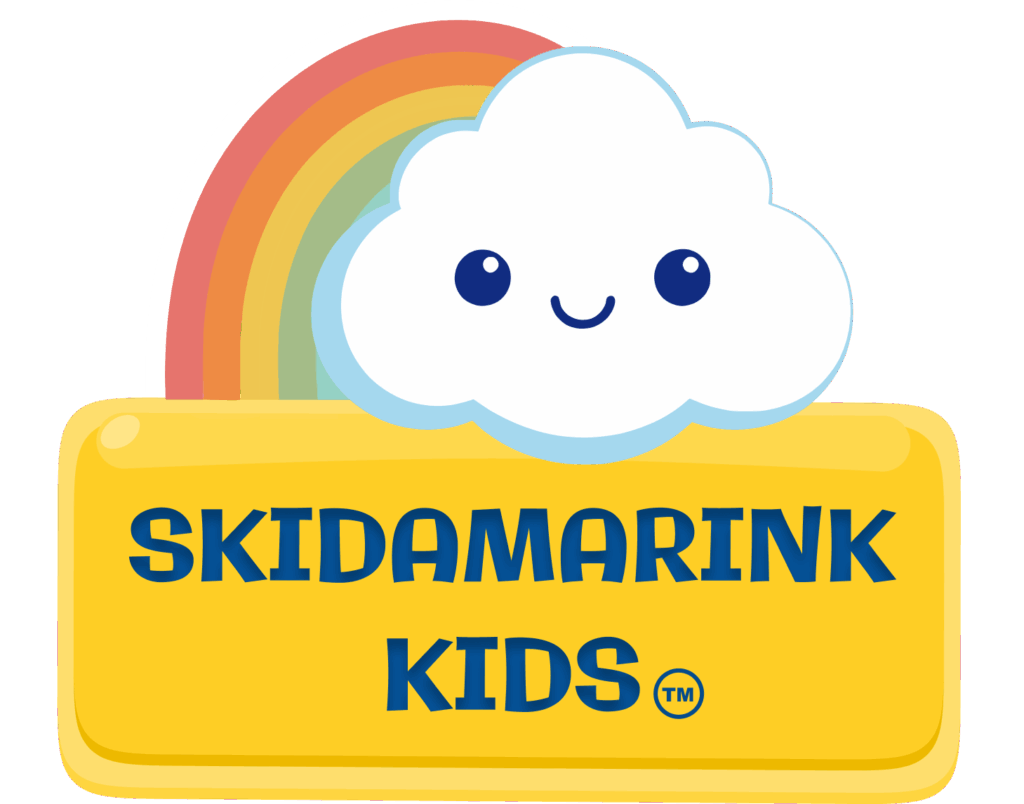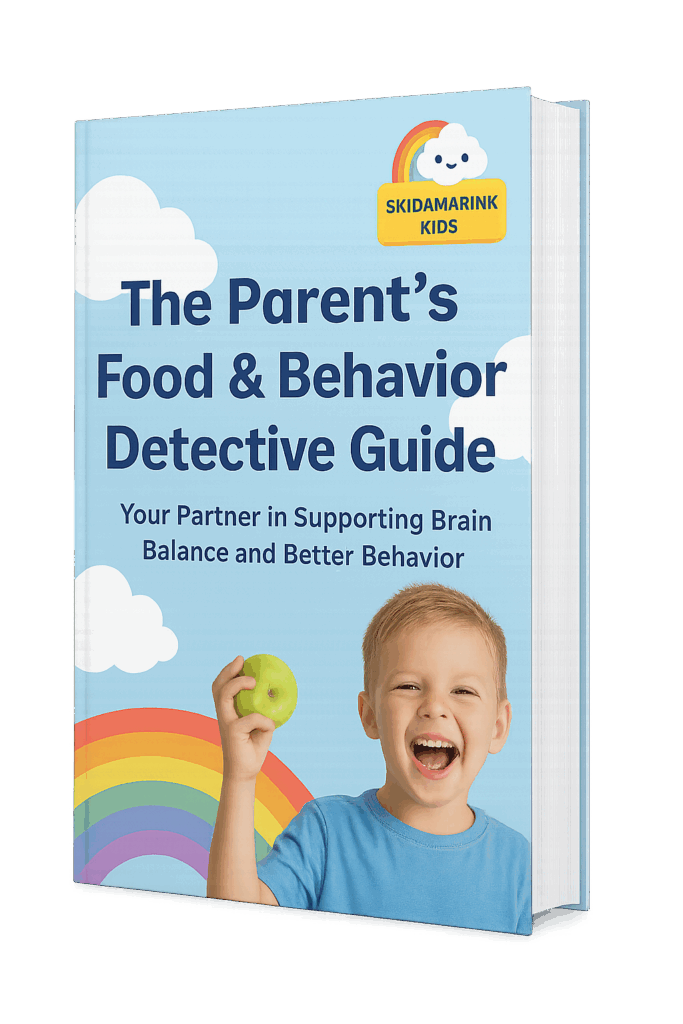Your 4-year-old had a cheese quesadilla for lunch on Monday. By Tuesday afternoon, he’s a completely different kid – angry, hitting his sister, throwing toys, and unable to focus. You’re wondering if there’s a connection, and you’re right to question it. Understanding child food sensitivities and behavior could be the key to what’s happening with your child.
Or maybe your daughter refuses all vegetables and won’t even let them touch her plate. Certain textures make her gag instantly – even foods she used to love like scrambled eggs. These patterns might seem random, but there could be a real connection you haven’t discovered yet.
This is Part 2 of our nutrition series. Part 1 covered how nutrition affects child behavior through basic food choices. Now we’re diving deeper into how sensitivities show up and when to seek professional attention.
My Daughter's Story
I know firsthand how challenging this journey can be. My daughter’s behavior was dramatically affected by the foods she ate. Her teachers could often tell if she had eaten something she wasn’t supposed to by her behavior at school. Some days she’d be calm and focused. Other days, she’d be completely dysregulated, unable to control her emotions or body.
The connection between child food sensitivities and behavior can be challenging to identify. Yet with the right support, you can help address them to better support your child’s behavior. I’m sharing what I learned through our journey to help you navigate yours.
Child Food Sensitivities vs Food Allergies: What's the Difference?
Many parents confuse these two conditions. They’re totally different. Knowing the distinction matters for your child’s health.
Food allergies involve the immune system responding immediately. Your child eats peanuts. Within minutes you see hives, swelling, or breathing problems. This is an IgE reaction that can be life threatening. Immediate medical attention is needed.
The Sneaky Nature of Sensitivities
Food sensitivities work differently and way harder to detect. The body produces a reaction that takes one to three plus days to show up. When your child drinks milk on Monday, the meltdown happens Wednesday. Without careful tracking, you’d never connect the two.
For example: Your son eats mac and cheese (dairy and gluten) on Sunday. Monday he seems fine. Tuesday morning he wakes up congested. By Tuesday afternoon, he’s having epic meltdowns over tiny things. Wednesday his stomach hurts and he’s still irritable. Most parents think he’s coming down with something. It might be the mac and cheese.
This delayed reaction makes sensitivities incredibly hard to identify without careful tracking. Your child seems totally fine right after eating the problem food. Then days later, you’re dealing with behavioral issues, stomach pain, or mood swings that seem to come from nowhere.
Why Brain Balance Matters for Food Sensitivities and Behavior
Before we dive into symptoms, I have something you might find important to know. It is believed that food sensitivities is a symptom of brain imbalance. God designed our brains to develop in a pattern in which the right side of the brain starts to develop first to create a good foundation. Then the left side of the brain builds on this. When the brain develops in a balanced way, there is good communication between both hemispheres. This leads to good neurological and sensory processing, along with good internal processes like immune support and digestion.
The Brain Balance Connection
When this balance is disrupted, then it leads to an imbalance know as Functional Disconnection Syndrome. This happens when the two sides of the brain mature at different rates. This causes communication problems. Instead of working together as a balanced team, one side of the brain works too fast. The other works too slow. This leads to over-reliance on one side. It creates the challenges that so many families face today.
Poor nutrition especially during early development plays a role in why this imbalance occurs. Food sensitivities and leaky gut syndrome are symptoms of this. Sensitivities and sensory eating challenges often happen together.
Understanding this connection helps you see the bigger picture. For more information about brain imbalance and nutrition check out the Brain Balance Center as wells as my blog Why My Child Can’t Self-Regulate: Understanding the Root Causes. For children who appear to have an imbalance that maybe leading to sensitivities, sensory issues including picky eating, I have practical tips to help address these. In addition to seeking support if you suspect this, check out my blog How to Calm Child Naturally: Brain-Supporting Activities.
How Child Food Sensitivities and Behavior Are Connected
Food sensitivities don’t just cause physical symptoms. In fact, they directly impact the brain and nervous system. Consequently, this leads to behavioral and emotional challenges.

The Gut-Brain Connection Is Real
Your child’s gut and brain communicate constantly. When foods trigger inflammation in the gut, that inflammation signals the brain. As a result, mood swings are more likely to happen. Children may become more irritable and have difficulty focusing. This can lead to frequent behavioral outbursts.
This isn’t your child purposely being difficult. Instead, it’s their body responding to foods it can’t process well. Moreover, the inflammation affects neurotransmitter production. Ultimately, this leads to actual changes in brain function and behavior.
Common Signs You'll Notice
Watch for these patterns that suggest child food sensitivities and behavior connections:
Behavioral symptoms:
- Sudden mood swings or emotional meltdowns
- Increased aggression or defiance
- Anxiety or fearfulness
- Hyperactivity or inability to sit still
- Difficulty focusing or paying attention
- Sleep problems or night waking
- Irritability and low frustration tolerance
Physical symptoms:
- Frequent stomachaches or digestive issues
- Chronic congestion, runny nose, or ear infections
- Skin issues like eczema, hives, or rashes
- Dark circles under eyes
- Chronic constipation or diarrhea
- Headaches
- Getting sick frequently
Notice patterns where behavior worsens after certain meals? Therefore, sensitivities might be playing a role.
The Detective Work: Tracking Child Food Sensitivities and Behavior
To identify connections, you need to track carefully. Random observations aren’t enough. Importantly, that delayed reaction time makes this hard.
What You Should Track
You’ll need to track for at least 7 days (14 is better):
- What your child eats (every meal, snack, drink)
- When behavioral issues happen
- Physical symptoms that appear
- Sleep quality and patterns
Remember the 1-3 day delay. Behaviors you see today might connect to foods eaten 1-3 days ago. Consequently, this is why tracking over time reveals patterns you’d never notice otherwise.
For example: Monday your son eats pizza (dairy and gluten). Tuesday he seems fine. By Wednesday afternoon, he has an epic meltdown at school – his teacher says he couldn’t focus all day. Thursday his stomach hurts. Understanding child food sensitivities and behavior patterns through tracking helps you connect Wednesday and Thursday’s issues back to Monday’s pizza.
Need help tracking effectively? Our FREE Parent’s Food & Behavior Detective Guide includes complete 7-day tracking templates, instructions on what to track, and how to identify patterns. Download your free guide here (coming soon) to make the detective work way easier!
🎯 TRY THIS TODAY: Download and print the 7-Day Tracking Template from the free guide below. Post it on your fridge and commit to filling it out for one week starting today.
What to Do Once You Suspect Food Sensitivities Affect Behavior
Once tracking reveals potential problem foods, talk to your child’s doctor before making major dietary changes. This is really important. Additionally, sensitivities can be complex, and you want professional guidance.
Getting Professional Guidance
Your doctor may suggest:
- Blood tests for food allergies (IgE) or sensitivities (IgG)
- Working with a pediatric nutritionist
- Trying an elimination approach under supervision
- Ruling out other medical conditions
Some parents find elimination approaches helpful for confirming sensitivities, but this should always be done with medical supervision. Your child’s doctor or a pediatric nutritionist can ensure your child still gets enough nutrition while identifying trigger foods.
Our FREE guide (coming soon) includes detailed information on food swap charts and questions to ask your doctor. However, professional guidance is essential for using these strategies safely.
Sensory Eating Issues and Child Food Sensitivities
Sometimes what looks like sensitivities is actually sensory processing challenges. Alternatively, it’s both happening together.
Recognizing Sensory Red Flags
Sensory eating issues include:
- Extreme reactions to food textures
- Gagging with certain consistencies
- Refusing foods based on smell alone
- Only tolerating specific temperatures
- Extreme pickiness about food touching
For example: Your daughter gags when she sees yogurt. She’s not allergic or sensitive to it. Rather, it’s because her brain can’t process the texture comfortably. Her right brain isn’t developed enough to handle that sensory input.
Children with sensory eating challenges often have right brain weakness. The right brain processes sensory information. When it’s underdeveloped, children struggle with how food looks, smells, feels, and tastes.
This can overlap with child food sensitivities and behavior. Your child might genuinely be sensitive to certain foods. However, they also might have sensory processing challenges making all food experiences overwhelming.
When Extreme Pickiness Needs Professional Help
If your child shows both sensitivities and extreme pickiness, they might need professional feeding support. Some children eat fewer than 20 foods, show extreme distress at meals, or have growth concerns. These signs indicate problem feeding that goes beyond typical pickiness.
Talk to Your Pediatrician First Help for Food Sensitivities and Behavior
You don’t have to figure this out alone. Know when to reach out for support.
Talk to your pediatrician if:
- Your tracking reveals concerning patterns
- Behaviors are worsening despite your efforts
- Your child’s growth is affected
- symptoms are severe or persistent
- You want to discuss sensitivities or elimination approaches
Bring your tracking logs to appointments. They provide clear information that helps doctors understand your child’s patterns and make appropriate referrals.
Other Professionals Who Can Help
A pediatric nutritionist or dietitian ensures your child gets enough nutrition while managing sensitivities. They create meal plans that work for your family.
An occupational therapist addresses sensory issues that affect eating. They also help with self-regulation and daily functioning.
Speech therapists work on oral motor skills and feeding mechanics, which can be crucial for children with eating challenges.
Feeding specialists are trained in childhood feeding disorders using specific methods to help children overcome food aversions, this is usually a speech therapist or an occupational therapist.
A functional medicine practitioner takes a whole-body approach, focusing on gut health and root causes of sensitivities.
An allergist tests for true food allergies and helps manage them safely through testing and treatment plans.
Use our FREE guide’s “Questions to Ask Your Pediatrician” checklist to prepare for productive appointments.
Stop Wondering If Food Is Affecting Your Child's Behavior
Tired of mystery meltdowns that seem to come from nowhere?
Wondering if those dark circles and constant congestion are related to what your child eats?
Download the FREE Parent’s Food & Behavior Detective Guide and finally get answers.
You’ll get:
- ✓ Complete 7-Day Food & Behavior Tracking Templates
- ✓ Common Food Sensitivities Checklist with behavioral and physical symptoms
- ✓ Daily Checklist for Brain-Supporting Nutrition to support your child every day
- ✓ Easy Food Swap ideas for brain-supporting nutrition
- ✓ Safe Foods List Template to track what works for YOUR child
- ✓ Protein Snack Ideas for stable blood sugar and better behavior
- ✓ “Questions to Ask Your Pediatrician” Checklist for productive appointments
Stop guessing. Start tracking. Get clear answers about what’s really affecting your child.
Start understanding your child’s unique needs today!
Transform Chaos Into Calm. Build the Neurological Foundation for Happy, Capable, Self-Regulated Kids.
Download the Tantrum Tamer App today to start supporting your child’s brain balance and bringing more calm to your home.
The Path Forward with Child Food Sensitivities and Behavior
Understanding how child food sensitivities and behavior connect changes everything. Your child isn’t likely being difficult on purpose. Instead, their body might be reacting to certain foods. This can show up as behavioral, emotional, or physical symptoms.
You can start where you are today. Begin tracking what you notice. Look for patterns in your child’s behavior. Working with your child’s doctor is essential, and don’t hesitate to seek help when needed.
Every child is unique. What works for one might not work for another. Patience and consistency are key. Some days you’ll see improvements. Other days feel like setbacks. Nevertheless, both are normal.
You’re not alone in this journey. Many families navigate these challenges. With the right information, support, and strategies, you can help your child thrive.
Keep Learning About Your Child's Needs
Start with the basics: How Nutrition Affects Child Behavior: What Every Parent Needs to Know explains foundational nutrition principles.
Understand picky eating: Picky Eating vs Problem Feeding: When Should Parents Worry? helps you know when eating challenges need professional support.
Learn practical feeding strategies: How to Help Picky Eaters Try New Foods: Food Exposure Strategies That Actually Work provides step-by-step methods.
Understand behavior challenges: Why My Child Can’t Self-Regulate: Understanding the Root Causes explores how brain development affects behavior.
Trust your instincts about your child. You know them better than anyone. If something feels off about their eating or behavior around food, you’re probably right. Getting help isn’t admitting failure. It’s being the advocate your child needs. You’re doing an amazing job navigating these complicated challenges.
Note to Parents
I am an occupational therapist with extensive experience working with families and my own children around nutrition and behavior. This information is educational and based on research and clinical experience. Always consult your child’s pediatrician or a qualified nutritionist before making significant dietary changes. I support a holistic approach to child health and encourage you to work with professionals who share this perspective.
– Kendra









